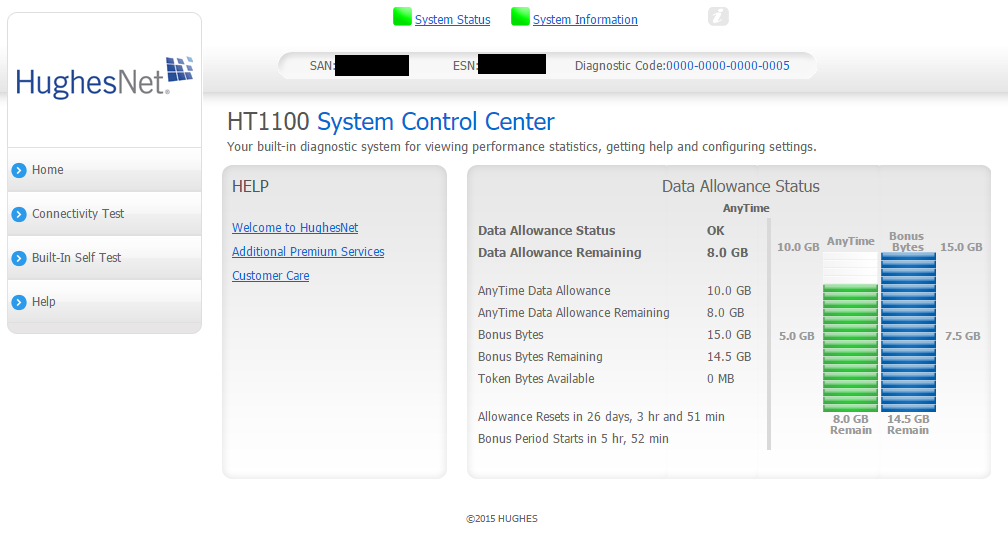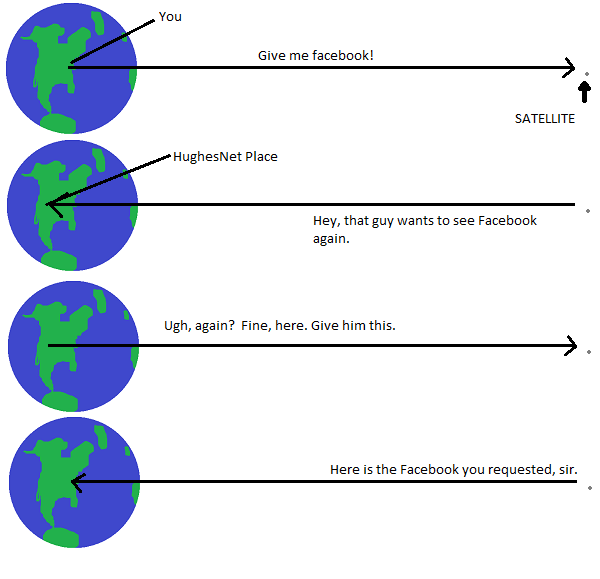I’m currently at my parents’ house in a rural area. This is what their modem’s control panel looks like right now:

The most important part is this:
AnyTime Data Allowance 10.0 GB
The bandwidth cap here is 10 GB/month. That’s TINY. Even the stingiest wired ISPs provide around 250 GB for their plans. The worst part is that my dad pays more for this horrible service than a more reasonable plan.
Why?
Because it’s the best option in this area.
Why can’t rural areas get access to decent internet?
Even in a small town, it’s not that hard to have a decent Internet connection. DSL or cable is readily available. But if you travel a few miles away from those small towns, not even DSL is available. This is how DSL works:
On the customer side, the DSL Transceiver, or ATU-R, or more commonly known as a DSL modem, is hooked up to a phone line. The telephone company connects the other end of the line to a DSLAM, which concentrates a large number of individual DSL connections into a single box. The location of the DSLAM depends on the telco, but it cannot be located too far from the user because of attenuation between the DSLAM and the user’s DSL modem. It is common for a few residential blocks to be connected to one DSLAM. – Wikipedia: DSL
Balanced pair cable has higher attenuation at higher frequencies. Therefore, the longer the wire between DSLAM and subscriber, the slower the maximum possible data rate due to the lower frequencies being utilized to limit the total attenuation (or due to the higher number of errors at higher frequencies, effectively lowering the overall frequency/data rate). The following is a rough guide to the relation between wire distance (based on 0.40 mm copper and ADSL2+ technology) and maximum data rate. Local conditions may vary, especially beyond 2 km, often necessitating a closer DSLAM to bring acceptable bandwidths:
25 Mbit/s at 1,000 feet (~300 m)
24 Mbit/s at 2,000 feet (~600 m)
23 Mbit/s at 3,000 feet (~900 m)
…
3 Mbit/s at 15,000 feet (4.5 km)
1.5 Mbit/s at 17,000 feet (~5.2 km) – Wikipedia: DSLAM
Basically, an ISP that provides DSL places these DSLAMs in areas where enough people will sign up for DSL to make the service profitable. In rural areas, this simply isn’t feasible. Take my parents’ neighborhood, for example:
- If there were a DSLAM anywhere near them, there would likely be a maximum of ~100 people who could possibly connect to it due to range when using a 17,000-foot range as listed in the Wikipedia quote above.
- Some of their neighbors don’t want high-quality Internet access. This brings the number of possible subscriptions down.
- The phone lines in rural areas aren’t exactly new. Some areas have phone lines that are 30+ years old – even dial-up on many lines can be limited. These bad lines would dramatically decrease the range of a DSLAM – if it even worked at all.
So DSL in rural areas isn’t really a viable option for providers. So what about satellite Internet makes it so slow?
How Satellite Internet Works
This is how satellite internet works:

There are five main steps to satellite Internet:
- You type rwenger.com and press enter. Your satellite dish says “Hey, get Robert’s blog” to the satellite.
- The satellite relays that message to a place back on Earth where these requests are processed.
- That place finds the website with their Internet connection.
- They send the page back to the satellite.
- The satellite sends the page back to you.
It’s obviously a little more complicated, but you get the gist. Signals go between the Earth and the satellite 4 times in this process. How much time does that take? First, we need to know where the satellite is.
Satellites for satellite Internet are in geostationary orbit. This means the satellite is 22,236 miles above the equator, and it orbits the Earth every 24 hours. This makes it so that the satellite stays in the same place in the sky all the time, and you don’t have to keep moving your satellite dish as the satellite moves around the Earth. That would be a problem, so the satellite is kept in the same place above the ground all the time.
For the sake of simplicity, let’s say the customer’s satellite dish is on the equator and directly below the satellite, placing the satellite exactly 22,236 miles away. If the signal travels that distance 4 times, that’s 88,944 miles. These signals are in the electromagnetic spectrum, so they travel at the speed of light (186,282 miles/second). Something going that fast takes ~0.48 seconds to make the entire trip. So if you use a satellite in geostationary orbit, you will wait at least half a second before the page even begins to load, no matter what!
As far as an Internet connection goes, that’s forever.
Once a connection is established, it’s also pretty slow compared to a wired connection. One reason for this is because sending hardware to space is expensive. The cheapest satellite launches for communications satellites right now are around $60 million, and that’s not even including the cost of the satellite itself – easily hundreds of millions of dollars in some cases. Once the hardware is in space, it’s not really possible to change it either, so the company is stuck with years-old satellites meant to deliver lower speeds than what might be possible today. Generally, the fewer satellites a company needs, the cheaper it is, so satellite Internet providers don’t want to launch a lot of extra satellites. And since many customers share each satellite, speeds slow down and bandwidth caps make sure no one uses “too much”.
Alternatives
Besides moving, there aren’t really many other options for rural Internet right now. Cell towers work, but they are also spread thin in rural areas and have data caps. If a cell tower is close enough to your house to be reliable, that’s great, but in many places that’s unlikely.
So let’s make satellite Internet better. How? Move the satellite closer.
Satellites orbiting in Low Earth Orbit are much closer at 100-1200 miles. If there were a satellite 400 miles away, we could communicate with an ISP’s request processing place in about 0.01 second. That pretty much eliminates the issue of lag for gaming, delayed page loading, and requests timing out.
It would work, but it needs a lot of satellites. Objects in low earth orbit (like the space station) cross the sky in just a few minutes. That means that your satellite dish needs to find a new satellite continuously. It also means mean a LOT of satellites in operation at once, and that’s expensive. You would also need a more complicated satellite dish at your house to find multiple satellites simultaneously and point at them. Those are a few reasons why we don’t have really fast satellite Internet – yet.
The most notable company working on a Low Earth Orbit satellite constellation is SpaceX, who have also been doing this lately:
They want to make access to space cheaper by reusing the rocket, which would make it easier to loft satellites into position to beam down cat gifs to rural consumers. Anyone in a rural area should be rooting for more cell towers and SpaceX success, as they seem to be your best hope for high-quality internet within the next 10 years.
———
PS: Here’s a SpeedTest result for anyone interested:
